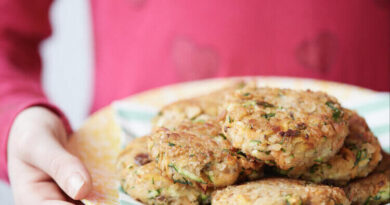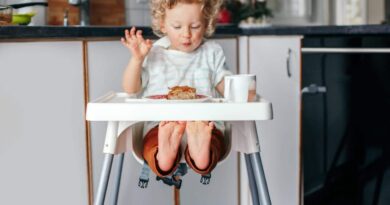Why is food sustainability important to teach kids about?
Many of us are becoming more conscious about climate change, looking after the environment and want to bring our families up in a more sustainable way.
The way we shop, eat and cook play a huge role in terms of environmental impact and our choices can have a knock on effect on food sustainability.
In addition, our children are growing up with this knowledge. They are learning about the need to save our planet and so I wanted to write a blog to give you some ideas for how you can teach your children about food sustainability.
This blog was originally published in 2020 and written by my colleague, Registered Dietitian, Gaby Goodchild.
If you would like a PDF version of this blog delivered directly to your inbox, pop your details below.
What is sustainability?
Sustainability is all about meeting our current needs without making it difficult for future generations to meet their needs (1).
You may have heard phrases such as ‘sustainable living’. This has come about because we are currently using our resources at an unsustainable rate and this cannot continue into the future.
Natural resources such as trees, water and coal are being used up. Sustainable living is all about changing the way we use these natural resources, so that we can provide a secure future for our children and their children.

Why is food sustainability important?
The way we choose to shop and eat, has put a lot of stress on our planet and the environment.
We need to stop this threat (1).
Our current food system has contributed to climate change, deforestation, soil loss and soil pollution, alongside a huge demand on water supply, pollution and exploitation of certain species such as fish, to name a few (2). It’s frightening!
Understanding this and what we need to do, will help to ensure food security for now and our future generations.
But at the same time, we also need to make sure that any changes we make are also healthy for us (1).
What are the main issues with our food system?
- Food waste in the UK is very high, we throw away 10 million tonnes of wasted or spoiled food every year (2). There is no doubt that some of this is avoidable.
- Land is not being used effectively enough and food production is having a huge impact on greenhouse gases.
- Greenhouse gases such as carbon dioxide and methane trap heat within the earth’s atmosphere, adding to global warming (5) and we know that food production is responsible for up to 30% of our total greenhouse gas emissions (5).
- 70% of all the water humans use is because of our food systems (2). This is way too much.

What needs to improve?
We cannot continue to produce and eat food in the same way, so we need to think about how to change.
The UK climate change target is to reduce greenhouse gas emissions by 80% by 2050 (2).
In the main, agriculture including harvesting, processing, packing, distributing and selling, need to change (2).
How are we impacting food sustainability?
We have a part to play too, especially in what we buy, how we prepare, cook and what we throw away (2) and this is what we can teach our children.
Did you realise that of the 10 million tonnes of wasted food every year, 71% comes from in the home? (2).
The meat and dairy industry are big producers of greenhouse gases and have a huge impact on our environment (4).
How we eat in the UK contributes an average 2.1 tonnes of carbon dioxide per person, per year, which adds to the greenhouse gases.
How does food affect the carbon footprint?
We all have a carbon footprint. It’s the amount of carbon dioxide released into the air as part of our daily activities (8).
As carbon dioxide impacts climate change, many people are taking steps to try and reduce their own carbon footprint.
Food and drinks have a carbon footprint because of the machinery and resources used to grow, harvest, package and transport it.
If you buy local, seasonal produce you will reduce your carbon footprint and the impact on the environment.
Is the answer a plant based diet?
A plant based diet is often suggested as one solution for our future food plans. This could reduce greenhouse gas emissions, improve land and water use and take some of the pressure off our environment (2).
To give you an example of the impact, beef and fish for example have 38 times higher greenhouse gas emissions than potatoes (2).
Secondly, a plant based diet may also be better for our health (3).
Large intakes of red and processed meat has been linked to health concerns and there are recommendations to eat less red and processed meat (2).
The knock on effect will mean we eat less saturated fat and salt, which is better for us (3).

Nutritional considerations of plant based diets
Meat and dairy products are the main sources of some essential nutrients such as protein, calcium, iron, zinc, iodine, Vitamin A, D, riboflavin and B12 (2).
And so it’s not just a matter of switching to a plant milk or going vegan, very careful consideration must be taken to identify alternative sources of these nutrients especially with children. You won’t believe how many little ones develop nutritional deficiencies because of poorly planned diets.
If you are thinking of going plant based, please book in to see a NHS dietitian or arrange to see us so that you can be assured that your children will still meet their needs for growth and good health.
Considerations for reducing dairy products intake
The dairy industry has already taken steps to reduce their contribution to greenhouse gases (2) but it’s still not enough to save the planet. Reducing our milk intake would help further (2). However there are nutritional things to consider when reducing our dairy intake.
Dairy products are our main source of calcium, an important nutrient for bones, teeth and heart health (15). Alternative milks, yoghurts and cheese should be calcium fortified.
For children, dairy foods contribute to quite a bit of their energy and protein requirements. Many of the plant based alternatives are low in calories (energy) and low in protein so they will need to make up for these elsewhere in their diet.
Considerations for reducing fish intake
Children are meant to eat two portions of fish per week, with one of these an oily fish such as salmon, pilchards or fresh tuna (3).
However, overfishing has left some fish as threatened species (6), Greenpeace claims that over 90% of tuna and cod have already been caught and over 70% of fisheries are overfished.
Sea fishing can also cause destruction to habitats and catch other species such as dolphins or turtles by accident (6).
If we reduce fish intake we need to consider:
Protein intake – Fish is a great source of protein and as well as that it provides iodine, and omega 3.
It is very difficult to obtain omega 3 from plant foods, yes it is present in certain nuts and seeds but it’s in a form that our body has to convert for it to be useful, and the human body isn’t very good at this conversion.
Omega 3 is needed for eye and brain development and is thought to link to concentration and intellect in children, so not one to skip.

Is there a compromise?
Because totally plant based diets (vegan) are nutritionally challenging, we often recommend reducing intake of meat and dairy, rather than cutting these out completely (2).
If you are used to eating meat every day, perhaps try to have 2-3 meat free days per week.
This way you are helping save the planet but not putting you and your children’s health at risk.
Should we buy organic?
Organic means no pesticides have been used in the production of that food, the soil quality is better and there is a greater ‘biodiversity’. All in all this means the environment is protected so organic farming is considered more sustainable (8).
However organic food has it’s disadvantages, as well as costing more, it’s claimed that without using pesticides, land is not used as effectively so it uses more land to grow the same amount of organic food.
The jury is out on this one, you can make the decision to go organic or not for yourself.

What can we do at home to really make a difference?
The Intergovernmental Panel on Climate Change (IPCC) report 2019 (7), recommends steps we can all take to make a difference to food sustainability.
- Eat less meat and dairy foods.
- Throw away less food
- Buying more locally sourced foods.
- Shop seasonal foods
Here are some further steps to reduce food waste:
- Use re-closable and reusable packaging in the fridge to keep opened food fresher for longer (9).
- Remember ‘best before’ is not the same as ‘use by’ and food can be eaten after the best before date, as long as the condition of the food is still edible (9).
- Make sure you check out the storage details for that food and store according to the advice given.
Check out Love Food, Hate Waste for advice of optimum conditions for storing your favourite foods.
- Look for recycling information on packaging.
- Check your fridge temperature – UK fridges are on average 2 degrees too high, the correct fridge temperature is below 5 degrees (10). Setting your fridge to the right temperature could help milk and other items last three days longer (10).
- Meal plan ahead according to the dates of the food in your fridge. Download my handy family meal planner here to help you stay organised.
- I love this clever portion planner which can help make sure you buy enough, but not too much of the ingredients you need for meals, for your family (10).

Be inventive with recipes – did you know you can make soup from potato peelings? Or homemade pizza from the crust ends of the loaf.
Choosing to buy your food with minimal and recyclable packaging can reduce the amount of packaging waste ending up in landfill. Many baby food pouches for example are not recyclable and can only be placed in your rubbish bin (11).
Glass baby food jars may not be as convenient but are largely recyclable, although you may need to take them to your local recycling centre.
A company called Terracycle has teamed up with Ella’s kitchen to recycle all brands of baby food pouches and Ella’s Kitchen snack packaging to be made into other products (12).
Find your nearest drop off location at Terracycle.

What about packaging?
If you can, buy your food with minimal packaging and what does come in packets, check that it’s recyclable. These small steps can significantly reduce the amount of packaging waste ending up in landfill.
Did you know, many baby food pouches, for example, are not recyclable (11).
Glass baby food jars may not be as convenient but are recyclable, although in some areas you may need to take them to your local recycling centre.
Many supermarkets now collect plastic packaging at the front of their stores. This includes all brands of baby food pouches and snack packaging to be made into other products. You can search for your nearest recycling location with recyclenow.com.
Make good use of your freezer
- Freeze, freeze, freeze! – lots of people don’t realise you can freeze almost all foods and it’s perfectly safe to do so right up to the use by date (10). ‘Freeze on day of purchase’ is being removed from some packaging.
- Around 81% of fruit wasted is because we didn’t use it on time but almost all fruit can be frozen and used in the future for desserts or smoothies (10).
- 4.4 million potatoes are being wasted every day in UK homes (10). To freeze raw potatoes, boil them for about 5 minutes and freeze them for later. When you want them you can defrost them overnight and roast the next day.
- Did you know you can also freeze cheese? Grate ahead of freezing and grab a handful for cooking when needed.
- Bread can also be frozen when you buy it or try freezing the last few slices of a loaf before it’s past its best.
- Milk is best frozen on the day of purchase. You can freeze in the containers but beware the milk will expand when frozen. Freeze portions of milk in ice cube trays before you go on holiday, which can be quickly defrosted for your cup of tea when you get home! (10).

We have a masterclass all about making the most of your freezer to help food sustainability and save money, inside the Happy Healthy Eaters Club. Click Here to learn more.
Tips for buying more locally
If all our food came from within 20km of where we live, we could save £1.2 billion per year on environmental and congestion costs (13).
Here are my tips on buying locally:
- Find out about your local farm shops and farmers markets at http://www.farmshop.uk.com/.
- Find your local milkman at https://www.findmeamilkman.net/ and have your milk delivered in reusable glass bottles, rather than plastic packaging.
If you’ve enjoyed what you’ve learned here then I’d like to introduce you to the Happy Healthy Eaters Club. This is a members-only club where you’ll learn how to raise a child who skips to the table (without you having to ask 50 times first), sits down, and happily munches away.
The club will teach you all about food and parenting techniques so that you can nip fussy eating in the bud (or prevent it before it begins) and make you’ll feel safe in the knowledge your child has eaten their nutrients, that they’ll sleep well, grow healthy bones and brains, and not pick up all those bugs.
Your parenting around food means that your little one will learn to be excited to try new foods, family mealtimes are a breeze and there’s not a reward, bribe, or iPad insight and you haven’t spent hours in the kitchen cooking up different meals for everyone either. And I promise you… you’ll no longer be scraping rejected food from the floor! Here’s the link to learn more: https://www.thechildrensnutritionist.com/hhec-open

The post Why is food sustainability important to teach kids about? appeared first on The Children's Nutritionist.



